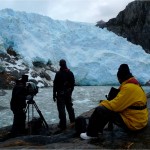 Since 2002, researchers from the New York Botanical Garden (NYBG) and the Universidad de Magallanes to better understand and conserve the amazing diversity of mosses, lichens and liverworts found in the Cape Horn archipelago. Early results of this collaboration showed that Cape Horn hosts 7% of the world’s diversity of non-vascular plants on only 0.01% of the planet’s surface area. Using this information, the Omora Park’s team of students, philosophers and scientists turned this ecological fact into socially relevant results, including part of the justification of the creation of the Cape Horn Biosphere Reserve (CHBR) in 2005.
Since 2002, researchers from the New York Botanical Garden (NYBG) and the Universidad de Magallanes to better understand and conserve the amazing diversity of mosses, lichens and liverworts found in the Cape Horn archipelago. Early results of this collaboration showed that Cape Horn hosts 7% of the world’s diversity of non-vascular plants on only 0.01% of the planet’s surface area. Using this information, the Omora Park’s team of students, philosophers and scientists turned this ecological fact into socially relevant results, including part of the justification of the creation of the Cape Horn Biosphere Reserve (CHBR) in 2005.
In 2010, this inter-institutional and international team of researchers, including not only NYBG and the University of North Texas, but also individuals from the Field Museum, Duke University and the California Academy of Sciences, obtained new funding from the U.S. National Science Foundation to conduct a series of month-long, boat-based expeditions in Cape Horn between 2011 and 2014. These trips to remote areas that are difficult to access and infrequently visited will allow scientists to collect and identify specimens with the goal of creating a complete inventory of the moss and liverwort species found in the archipelago and publish a definitive work on the Bryoflora of Cape Horn.
Through the SABCP, this basic science project is also linked with local research, education and conservation initiatives based at the Omora Park, which is one of three networked long-term socio-ecological research sites in Chile. For example, the Omora Park has been developing a novel special interest tourism project with the support of the Chilean Ministry of Economy’s Corporation for Business Development (CORFO), which is enabling the improvement of training, publications and infrastructure for the implementation of “Tourism with a Hand Lens”, a unique opportunity for local tourism operators to obtain economic benefit by leading visitors on a discovery of the singular diversity of bryophytes and lichens found in the Omora Park and Cape Horn archipelago.
Plus, in addition to the funding from the NSF, partial support of the current expedition (January-February 2011) has also been provided by the Weeden Foundation, based in New York, to aid the participation of Chilean students from the Universidad de Magallanes’ Masters of Science in Sub-Antarctic Conservation Program. In this way, students working on projects in marine science, invasive species, moss/insect interactions and watershed ecosystem services were also able to participate with the prestigious team of bryologists, thereby facilitating broader impacts of this expedition in the areas of interdisciplinary research and training of students from the U.S. and Chile.

 Cape Horn is globally known as a landmark for sailing and as the closest point of land to Antarctica, where hurricane force winds and torrential rains lash the coast year round. However, increasingly, thanks in part to the work of the Sub-Antarctic Biocultural Conservation Program (SABCP), it is becoming equally renowned for its diverse climates and ecosystems that create a unique combination of biological and cultural diversity.
Cape Horn is globally known as a landmark for sailing and as the closest point of land to Antarctica, where hurricane force winds and torrential rains lash the coast year round. However, increasingly, thanks in part to the work of the Sub-Antarctic Biocultural Conservation Program (SABCP), it is becoming equally renowned for its diverse climates and ecosystems that create a unique combination of biological and cultural diversity.